
A tobacco pipe, often called simply a pipe, is a device specifically made to smoke tobacco. It comprises a chamber for the tobacco from which a thin hollow stem (shank) emerges, ending in a mouthpiece. Pipes can range from very simple machine-made briar models to highly prized hand-made artisanal implements made by renowned pipemakers, which are often very expensive collector's items.
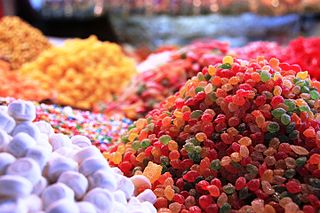
Candy, alternatively called sweets or lollies, is a confection that features sugar as a principal ingredient. The category, also called sugar confectionery, encompasses any sweet confection, including chocolate, chewing gum, and sugar candy. Vegetables, fruit, or nuts which have been glazed and coated with sugar are said to be candied.

Liquorice or licorice is the common name of Glycyrrhiza glabra, a flowering plant of the bean family Fabaceae, from the root of which a sweet, aromatic flavouring is extracted.
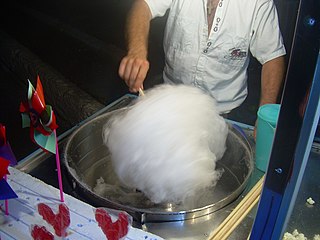
Cotton candy, also known as candy floss (candyfloss) and fairy floss, is a spun sugar confection that resembles cotton. It is made by heating and liquefying sugar, and spinning it centrifugally through minute holes, causing it to rapidly cool and re-solidify into fine strands. It usually contains small amounts of flavoring or food coloring.
Jones Soda Co. is a beverage company based in Seattle, Washington, United States. It bottles and distributes soft drinks, non-carbonated beverages, energy drinks, and candy.
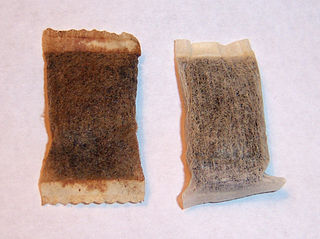
Snus is a Swedish tobacco product. It is consumed by placing a pouch of powdered tobacco leaves under the lip for nicotine to be absorbed through the oral mucosa. Snus, not to be confused with nicotine pouches, consists of ground up tobacco leaves, salt, an alkalizer and (optionally) flavorings. The final product is sold as both loose tobacco, and in portions with the tobacco mixture contained in a small teabag-like pouch.
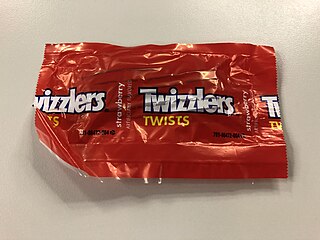
Twizzlers are a licorice-type candy manufactured by Y&S Candies, Inc., of Lancaster, Pennsylvania, a division of The Hershey Company. Twizzlers were first produced in 1929 by Young and Smylie, as the company was then called. The licorice company was founded in 1845, making it one of the oldest confectionery firms in the United States. Twizzlers ingredients consist of corn syrup, wheat flour, sugar, cornstarch, and smaller amounts of palm oil, salt, artificial flavor, glycerin, citric acid, potassium sorbate, Red 40, and soy lecithin. Despite only the black Twizzlers containing extracts of the licorice plant, Twizzlers products are collectively referred to as licorice-type candy. Seventy percent of the annual production of Twizzlers are strawberry, the most popular Twizzlers flavor.
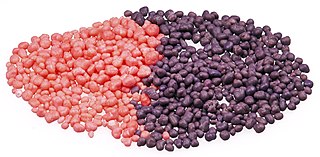
Nerds is an American candy launched in 1983 by the Sunmark Corporation under the brand name Willy Wonka Candy Company. Nerds are now made by the Ferrara Candy Company, a subsidiary of Ferrero Group. but is still distributed internationally by Nestlé. With their anthropomorphic covers, Nerds usually contain two flavors per box, each flavor having a separate compartment and opening.
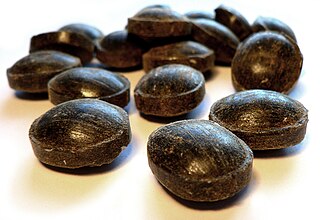
Tyrkisk peber is a salty liquorice candy flavoured with salmiac, produced by the Finnish company Fazer and popular in Northern Europe.

A bubble pipe is a toy shaped like a tobacco pipe, intended to be used for blowing soap bubbles.

Cavendish tobacco is tobacco that has been heat treated with fire or steam and then subjected to heavy pressure in order to produce a sweet taste with a moist texture. American, Dutch, and Danish varieties involve the addition of flavorings; while British Cavendish, commonly known as unsweetened or unflavored Cavendish brings out the natural sugars in the tobacco through pressure applied during the preparation process. Cavendish tobacco is named after Sir Thomas Cavendish.

Candy cigarettes are a candy introduced in the late 19th century made out of chalky sugar, bubblegum or chocolate, wrapped in paper and packaged and branded so as to resemble cigarettes. Some products contain powdered sugar hidden in the wrapper, allowing the user to blow into the cigarette and produce a cloud of sugar that imitates smoke, which comes out of the other end.

A tobacconist, also called a tobacco shop, a tobacconist's shop or a smoke shop, is a retail business that sells tobacco products in various forms and the related accoutrements, such as pipes, lighters, matches, pipe cleaners, and pipe tampers. More specialized retailers might sell ashtrays, humidification devices, hygrometers, humidors, cigar cutters, and more. Books and magazines, especially ones related to tobacco are commonly offered. Items irrelevant to tobacco such as puzzles, games, figurines, hip flasks, walking sticks, and confectionery are sometimes sold.

A tobacco display ban, point-of-sale display ban or retail display ban is a measure imposed in some jurisdictions prohibiting shops and stores from displaying tobacco products.

SmokinginCanada is banned in indoor public spaces, public transit facilities and workplaces, by all territories and provinces, and by the federal government. As of 2010, legislation banning smoking within each of these jurisdictions is mostly consistent, despite the separate development of legislation by each jurisdiction. Notable variations between the jurisdictions include: whether, and in what circumstances ventilated smoking rooms are permitted; whether, and up to what distance away from a building is smoking banned outside of a building; and, whether smoking is banned in private vehicles occupied by children.

In Finland, the smoking figures are among the lowest in Europe. There are several factors that have influenced the decrease in the smoking prevalence, such as legislative actions, health promotion and national monitoring systems, policies aimed at reducing tobacco consumption through public awareness campaigns, advertising bans and increased taxation. Ministry of Social Affairs and Health has the leading role in tobacco control in Finland, and one of their main aims is have a more effective ban on sale of tobacco products to children and young people and to prevent sale of illegal tobacco products. Among the key elements in the successful tobacco policy is the traditional collaboration between the health authorities and non-governmental organisations, and intensive health promotion.
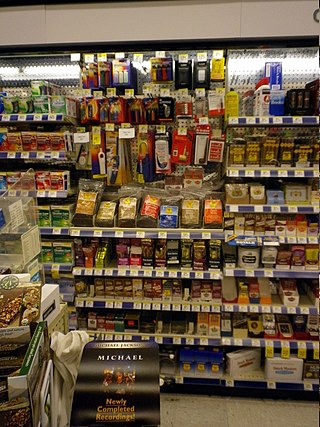
A tobacco-free pharmacy is a retail pharmacy where the sale of tobacco products is not available. Outside the United States, it is illegal in countries such as in France and most of Canada for pharmacy stores to sell cigarettes and similar products on the same premises as over-the-counter drugs and prescription medication. Anti-tobacco campaigners advocate the removal of tobacco from pharmacies due to the health risks associated with smoking and the apparent contradiction of selling cigarettes alongside smoking cessation products and asthma medication. Some pharmaceutical retailers counter this argument by reasoning that by selling tobacco, they are more readily able to offer to customers advice and products for quitting smoking.

Fireball Cinnamon Whisky is a mixture of Canadian whisky, cinnamon flavoring and sweeteners that is produced by the Sazerac Company. Its foundation is Canadian whisky, and the taste otherwise resembles the candy with a similar name, Ferrara Candy Company's "Atomic Fireball" candy. It is bottled at 33% alcohol by volume.

Regulation of electronic cigarettes varies across countries and states, ranging from no regulation to banning them entirely. As of 2015, around two thirds of major nations have regulated e-cigarettes in some way. A 2023 report by the World Health Organization (WHO) found that 34 countries had banned the sale of e-cigarettes.


















